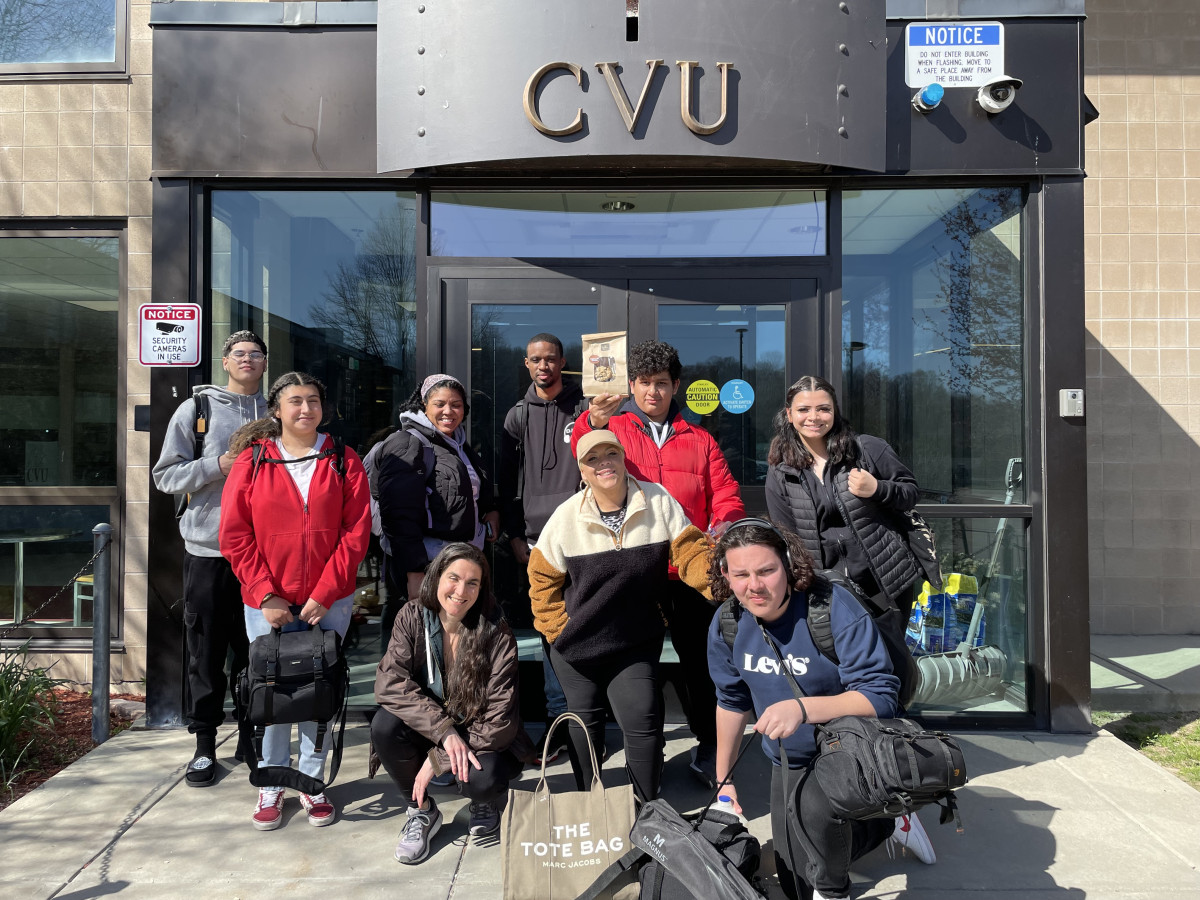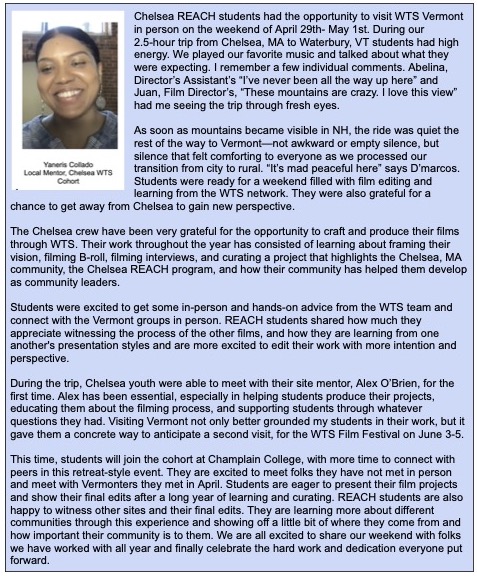What’s the Story? A *National* Young People Social Action Team
0June 3, 2022 by BLTN Staff

Over the past two years, What’s the Story? Vermont has begun to redefine “community spaces.” Originally conceived as the Vermont Young People Social Action Team, the program is in its eighth year of offering an unparalleled opportunity for Vermont students to work on issues of local importance, conducting interviews and other forms of research. During the pandemic, as WTS shifted much of its in-person programming online, program leaders have welcomed cohorts from beyond Vermont. This year, WTS had three cohorts of young people, each anchored by mentors associated with the BLTN Next Generation Leadership Network.
In the spirit of WTS, where the interview is a critical research tool, we questioned this year’s lead teachers, Erik Remsen and Alex O’Brien, about their experience with the transformation.
BLTN Journal: How did What’s the Story? Vermont change as a result of the pandemic?
Erik: I guess the first thing to say is the Vermont part of our title is not entirely accurate. After finishing out the 2019 – 2020 year remotely and knowing that 2020 – 2021 was likely to be conducted entirely remotely, our directors, Bill Rich and Tim O’Leary, decided to open the program up to other Next Gen sites. Last year we had students from around Vermont plus participation from the Navajo Nation. This year we have groups from Chelsea, Massachusetts (connected to the Lawrence NextGen site); Aiken, South Carolina; and Santa Fe, New Mexico as well as our cohort of Vermont students.
Being entirely remote has forced us to alter the amount of time we are all together. Prior to the pandemic, the cohort would gather for monthly overnight retreats. That’s impossible on Zoom so we’ve had to pare down the full group gatherings and focus on the essential bits. We used to ask our students to take their films public; that’s much harder to do in a pandemic. However, we’ve continued to stay focused on storytelling and filmmaking. I also think some of the full group camaraderie has diminished as a result of being totally online, though with film groups communicating weekly, if not more, they still form close bonds.
Something else we tried this year to enhance our Zoom Saturdays was to bring in a few professionals for discussions with the students. I think these went great. We had a television reporter and a documentary filmmaker speak with students and I think it was really valuable for students to ask these experts questions.

BLTN Journal: How is the program working this year?
Erik: Check back with me in early June after our film premier event. Joking aside, Alex O’Brien and I are lead teachers this year after co-founders, Bill Rich and Tim O’Leary decided to take a step back. Those are big shoes to fill, but I think it’s been a decent year. I think Alex and I compliment each other pretty well and Bill and Tim are always available to troubleshoot and lend a hand. The brief glimpses I’ve had of students’ films so far make me excited about what the finished products will look like in June.
I’ll also add that our mentor teachers have been crucial in helping things go smoothly. This year, we have mentor teachers at each of our non-Vermont sites. Yaneris Collado, Heather Jones, Susan Miera and Michael Martinez are essential because they are local access points for our students in other states. We didn’t have that last year when we first welcomed other NextGen sites. That physical distance was problematic and it’s been so helpful to have adults on board at each of our locations. I would not be feeling as confident about the final films being completed if it were not for these folks, along with Tim and Bill, our Vermont mentors. This program doesn’t function without the relationships the adult mentors build with the small groups.
BLTN Journal: We often hear about the unexpected learning that takes place during the year; can you talk about that phenomenon this year?
Erik: Zoom, breakout rooms, screen sharing, audio sharing. There’s so much Zoom related stuff I’ve had to pick up as a result of facilitating this course online. When you lead this course, you become so much more knowledgeable about filmmaking and storytelling and while some of that is picked up from the experts we’ve invited in, quite a bit comes from the students, who are often already well-versed in that world. And then there’s the window that has been opened by inviting in other NextGen sites. I exist here in the Vermont education bubble. In that bubble, we didn’t think twice about scheduling Zoom sessions on both Saturday and Sunday, after all Vermont is a very secular state. However, we quickly learned that Sundays don’t work for other sites because of religious commitments. We had to adjust and rethink.

English Language Teacher
Rick Marcotte Central School
South Burlington, VT
WTS Vermont Co-Teacher, 2021-22
BLTN Journal: Erik has set the stage with some insights about What’s the Story?: The Nationwide Young People Social Action Team. Would you please tell us about your particular experience with the cohort from Chelsea, Massachusetts?
This year I am collaborating with Yaneris Collado with What’s the Story? and her students from REACH, an after school program in Chelsea, MA, who have been attending monthly WTS trainings. These meetings occur over either one or two days for a total of 4-8 hours of programming. So far this year, the monthly retreats have taught students about the choices that filmmakers make as well as the basics of operating media kits. The first part of the year’s programming focuses on building community, working as a team, and learning about film making how and whys. After the initial learning about film making, groups were ready to work as teams. The students from Chelsea REACH have formed three film creation teams.
BLTN Journal: What topics are the Chelsea students taking on?
While all of the students wanted to tell stories about their home city, their film topics ranged from perceived danger in their city, programs that help to uplift youth to food insecurity, and homelessness.
BLTN Journal: Could you tell us a bit about how the Chelsea students have experienced the WTS film making process?
What’s the Story? film makers began their film projects by researching their topic and finding out who the local experts are. The next step involves the actual film production, and it has been really exciting to see this take shape. Students have been working in their communities to film interviews with local experts on their topics. We have begun work on the post-production phase that will continue into the spring. During post-production, the students will use WeVideo to create and publish their final films. As Erik mentions, the year will culminate in a film festival hosted in Burlington, Vermont. We are looking forward to this moment when young filmmakers from Vermont, Massachusetts, South Carolina and New Mexico will come together to celebrate their work and learn from each other with great anticipation.
In addition to attending What’s the Story? programming on a monthly basis, Yaneris and I stay in touch with our film teams weekly. During our meetings, we have had discussions of weekly film studies and learned how to use the media kits together. Now that we are in the production phase of the filmmaking process, I make time to meet with each film team individually. We discuss their film teams’ next action steps. We talk about interview subjects, draft interview questions together, and talk about using different tools to help shape their footage into a cohesive narrative. The REACH program at Chelsea meets after school from 3-6 PM. There have been many nights that the students stay late working on their films, and we have used grant funds to help provide food for “working dinners” during the film making process.
BLTN Journal: I’m sure there are logistics to be figured out for planning travel. How have you handled these? Yaneris and I have been working in collaboration to plan the end of the year trip. We wrote a pair of Goswami Action Grants to cover trip expenses including lodging, food, gas and activities over the three-day weekend. Yaneris’ grant also covers dinners for students who will be staying late and working long sessions during the time-consuming post production phase.
BLTN Journal: As the year draws to a close, are there any key learnings from your mentoring that you would like to continue to process? Sometimes it can be difficult to support students in individual or group work when we are not sharing a physical space. As this is our first year collaborating with Chelsea REACH, I am hoping that this will become easier as mentors onsite become more familiar with film making and the production process.
BLTN Journal: What kinds of growth have you seen in the Chelsea students this year? Over the course of the year I have seen these young people grow in their knowledge of film conventions, technical proficiency with film equipment, and in their teamwork and confidence.
Yaneris Collado is a 2021 Esperanza Fellow.
Alex O’Brien is a 2021 Vermont BLTN Fellow.
Category Featured, Spring / Summer 2022 | Tags:


Leave a Reply